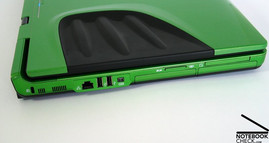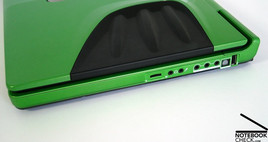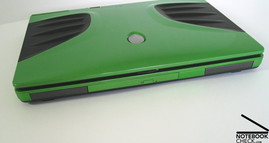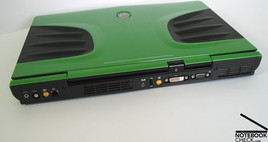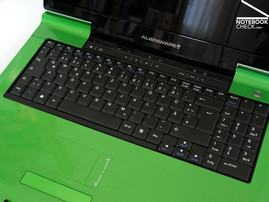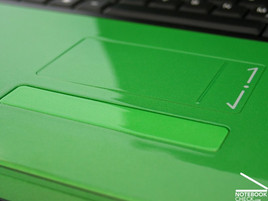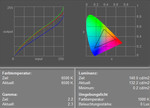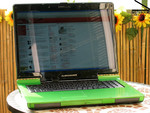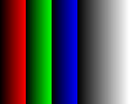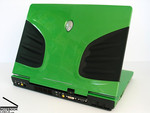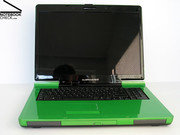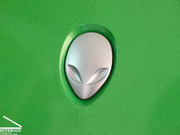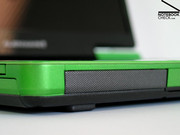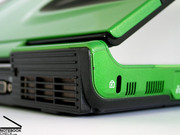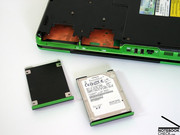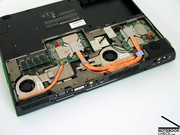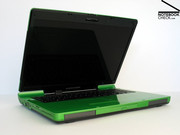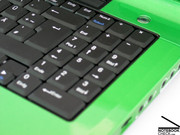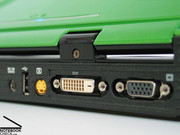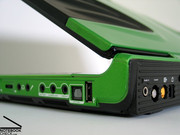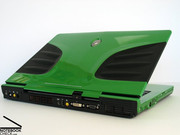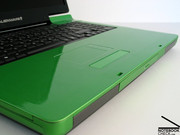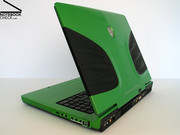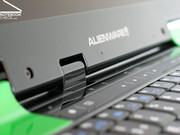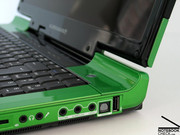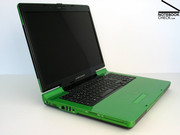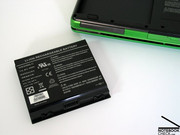Review Alienware Aurora m9700 Notebook
They are here.
Since now the notebooks reviewed at notebookcheck.net get new competitors. No, wrong. They are nearly eliminated by an alien competitor.
We are pleased to introduce the Alienware Aurora m9700 notebook - a notebook which has been nearly exclusively designed for hardcore gamer and which exceeds even some desktop computers in importance.
This review is dedicated to the young notebook seller who answered to my question whether he has got a gamer's notebook with the words: "If you want a computer for gaming, buy yourself a Gameboy or a Playstation".
Case
As it behooves for a notebook coming from the wide universe, which additionally is called Alienware, the primary color of the notebook is metallic bright green. Don't say this looks disgusting, nobody complained about the Little Green Men so far too.
The notebooks forms would remind on the inner side of a huge Star Trek Communicator, if it had not this horrible black standard keyboard with a separate number block. Dear Alienware designer, in a spacecraft of planet <697Gamma-c6> I do not expect to find a normal keyboard ;-)
The upper side of the display's cover suits a little better to the imagination of a alien electronic device. However, the Alienware Logo, which looks at you with its bright blue eyes, reveals the notebook soon as terrestrial.
Nevertheless, the interesting surface design leads to an impressive resistance against pressure. The display's flexural rigidity is also sufficient.
The display is hold be a big central hinge, which opens broadly with a creaking noise and a clear see-saw. A ramshorn hook keeps it securely in closed position.
The base unit seems robust too. Nevertheless, some smaller weaknesses like uneven gaps or pressure sensible locations can be detected.
All interfaces of the notebook are either on its backside or at both sides in the back regions. This avoids unnecessary cable spaghetti and keeps the locations left and right of the notebook free for the provided high-tech mouse pad or for docents of crisps and beverages for long nights and intensive LAN parties.
Not only does the order of the interfaces seems user-friendly, also the kinds and number of ports leaves nothing to be desired.
The DVD drive is placed somewhat unusual at Aurora m9700's front edge. At the left side there are two easily accessible slots for hard disks. Above them are the ExpressCard slot and a CardReader, followed by a firewire port, two USB 2.0 ports, a LAN interface and a Kensington lock.
The backside contains two vent holes and a variety of further interfaces. Besides the standard VGA-out there are e.g. also a S-Video out and a DVI port. Furthermore, there are a USB 2.0 port, the power connector, the modem interface, and S-Video in, a port for connection of an aerial and an audio in (3.5mm jack) at the opposite side of the user.
At the right side there is another USB port, 3 separate surround audio outs, an optical audio out as well as the standard audio ports (headset and microphone). In front of them there is control dial which allows controlling the volume.
Input Devices
Regarding the position of the keyboard - it is placed rather backwards in the case - it is evident that this leads to an unergonomic posture of the hands. Obviously, the keyboard is therefore rather not appropriate for long paperwork.
Despite of the separate number block the keyboard is clearly designed and user-friendly. Even the keys which are generally a little bigger have nearly no losses regarding their size. The enter key of the Alienware Aurora notebook extends over two rows, and it comes with a big right shift key, backspace key and space bar. On the contrary, there was not so much space left for the left shift key and the crtl keys.
The keyboard unit is firmly connected in the case and regarding typing without any anomalies. Maybe one can blame the keys of a slight position instability. However, it does not have any affect on typing.
Above the keyboard, there is a molding, which provides a variety of special functions (mail, browser, audio,...), which reacts at the slightest touch although it does not have any visual keys.
Anyway, the touch pad is in principal similar designed - placed without apparent gap and nearly at the same level than the surface. It is - like the surrounding case - bright green varnished. Therefore, its surface does not have optimal floating properties. If the fingers aren't absolutely dry, it is very cumbersome to place the mouse pointer. The buttons below is made out of one piece and has a relatively big dead zone in its middle region. However, it can be handled rather easily at the edges.
Display
The 17'' WUXGA "Clearview" display provides an absolutely complete picture with a maximum resolution of 1920x1200 pixels. There is therefore place for a maximum of 416!! icons in the desktop view. Sounds incredible, but it's true. Should you belong to the pixel fetishists: The notebook is also available with a resolution of 1440x900 pixels. Both version have reflecting surfaces, which is better regarding contrast and colors. However, one has to life with possible reflections.
By means of the color measurement diagrams, one can detect the nearly usual deviation of the blue color curve, which gives a hint on a reduced representation of this color range and a dominance of the red colors. So the colors appear slightly warmer compared to a correctly calibrated display.
| |||||||||||||||||||||||||
Brightness Distribution: 79 %
Contrast: 671:1 (Black: 0.2 cd/m²)
The measured maximum brightness is 134.2 cd/m². Compared with other 17'' notebooks this value is rather moderate. However, the Illumination of 79.1% is alright. As a result of the low black value of 0.2 cd/m² the contrast ratio is despite of the moderate brightness still positive at 671:1. This notebook rated grade 8 in the Pixperan test of legibility. This indicates a very fast speed of reaction, which is above-average, compared to similar displays.
The display could not convince us outdoors, but this not really necessary. As mentioned already quite frequently a display's legibility in very bright environments is on the one hand improved by a matt display, on the other hand by a brightness of above 150 cd/m². Because the Aurora m7900 is not good at both aspects, the outdoors legibility of the display is rather limited.
Regarding the stability to the vantage point the display has on the one hand a sufficient area of operation. On the other hand either the displayed images change rapidly (especially vertically) or the contrast diminishes with the vantage point.
Performance
The Aurora is equipped with 2 NVIDIA Geforce 7900 GS video cards (CPU/clock rate: 378MHz/400MHz, 2x 512 MB VRAM) and an AMD Turion 64 ML-44 Processor (2.4 GHz) and provides excellent performance. The Alienware's Aurora mALX (2x 7900 GTX GPUs) should even be better.
The GPU/clock rates are controlled dynamically and act upon demand. E.g. both video cards use a clock rate of about 100/100 MHz with 2D applications and with 375/500 MHz with performance demanding games.
The Aurora m9700 is not the notebook with the highest performance of all reviewed notebooks. The notebook with the highest performance is still the Nexoc E407 (Turion 64 MT-40 2,2 GHz / Geforce Go 7800 GTX SLI). However, this is a 19'' notebook. Amongst the 17'' notebooks it is practically unrivaled.
In order to anticipate questions like: "Can I also play game xy with this notebook?": The Aurora is currently one of notebooks with the highest performance. If not with this notebook, wherewith?
Another word to the Turion CPU: As got about in the meanwhile, MHz is not everything in the world of processors. This is the reason, why the classical Pentium with a clock rate of above 3 GHz, is no longer used. The future clearly belongs to multi core CPUs. If they come from AMD or Intel remains to be seen.
This fact explains the moderate results of the CPU during application performance tests. Well, I know: Who is interested in application benchmarks for a gamer's notebook - but I wanted to mention it for the sake of completeness.
Furthermore our reviewed notebook came with a 80GB Hitachi Travestar hard disk, which runs at 7200 revs and has an impressing performance. Top transfer times and access times speak for themselves. One negative aspect is the constantly creaking of the hard disk.
The notebooks comes with two slots for adding further hard disks. Therefore one can have a total hard disk volume of 320GB (2x160GB at 5400 revs) or. 200GB (2x100GB at 7200 revs). RAID1 configuration (mirroring for data security) is also possible.
Further information on the video card can be found here or in our comparison of mobile video cards. Detailed information about the Turion 64 CPU can be found here.
Please also look at our benchmark list of mobile processors or at our benchmark list of mobile video cards, in order to compare this notebook to other configurations.
| 3DMark 2001SE Standard | 24512 points | |
| 3DMark 03 Standard | 22136 points | |
| 3DMark 05 Standard | 9991 points | |
| 3DMark 06 Standard Score | 5076 points | |
Help | ||
| PCMark 04 Standard | 4263 points | |
Help | ||
Also reviewed:
Call of Duty II
1024x768, 4xAA: 35-80fps
1280x1024, 4xAA: 35-80fps
1600x1200, 4xAA: 30-50fps / 40-80fps (optimized for SLI)
Quake IV
Ultra Details, 16:10, 1920x1200: 50-60fps
2xAA: 50-60fps
4xAA: 30-60fps - jitters sometimes
8xAA: 10-40fps - no longer playable
Emissions
Loudness
It remains a wish that a notebook with a good performance is also very good regarding its emissions. No wonder, the waste heat of the 2.4 GHz processors and the 2 high-performance video cards must be somewhere dissipated. The Aurora therefore comes with two strong fans, which dissipate the waste heat at the notebook's back side. One of the fans is responsible for both of the video cards, whilst the other is responsible for the CPU.
Even in idle mode, the fans run after a short time and continue to run non-stop. Even a reduction of the performance through software settings or deactivation of the SLI mode, could not keep the fans from running. The measured noise in idle mode is 36.3dB. The rustling noise of the fans is thereby acceptable. Under load we measured noises of up to 43.2dB. Having in mind the excellent performance and a headset around ones ears, one can stand even this noise level.
Noise Level
| Idle |
| 32.8 / 41.1 / 36.3 dB(A) |
| HDD |
| 34.5 dB(A) |
| DVD |
| 42.7 / dB(A) |
| Load |
| 0 / 43.2 dB(A) |
 | ||
30 dB silent 40 dB(A) audible 50 dB(A) loud |
||
min: | ||
Temperature
Not surprisingly the fans are not able to dissipate all the waste heat. At the top side the Aurora m9700 still remains within an acceptable temperature range. However, at the bottom side near the back edge, next to the vent holes we measured temperatures of above 46°C.
Furthermore we have to mention the warming of the power supply unit. We measured up to 65.1°C. Therefore, one should take care to place the power supply unit in good aerated places and keep temperature sensible things out of its way.
Upper side
palmwrist: 27.8°C max: 37.1°C avg: 31.5°C
Bottom side
max: 46.8°C avg: 38.0°C hotspot: At the back edge near the vent holes
environment: 22.5
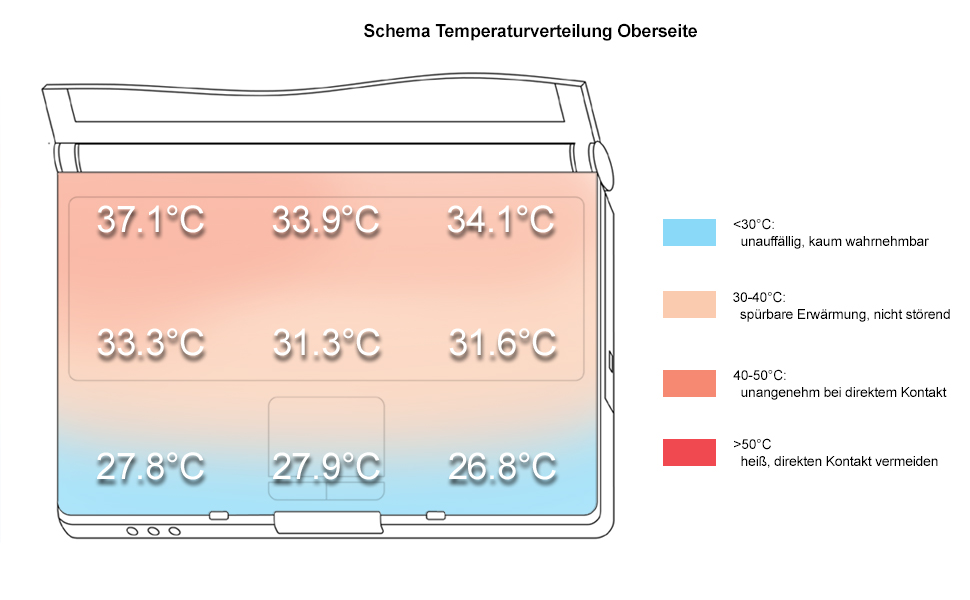
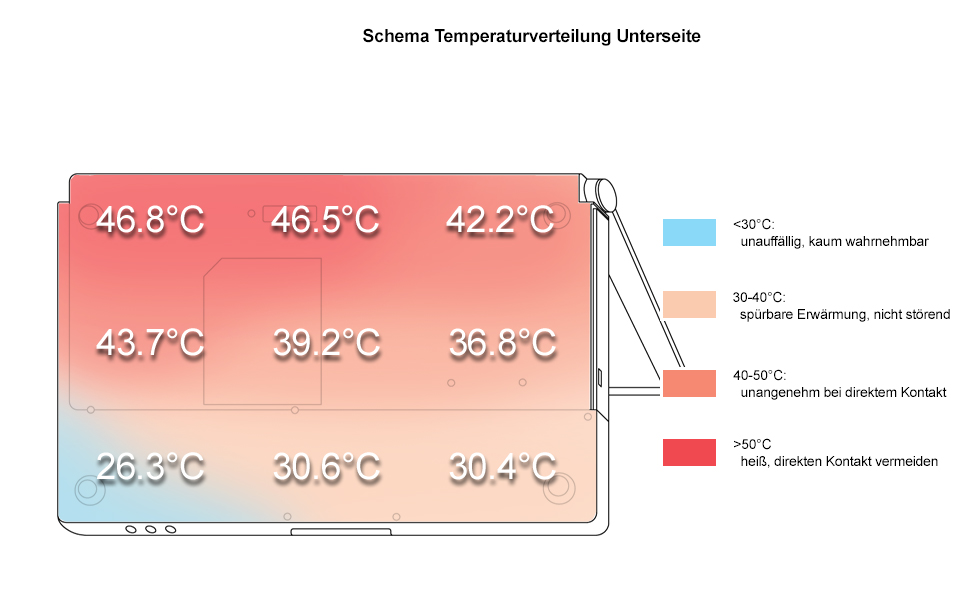
Speakers
The Alienware Aurora is equipped with 2 speakers left and right at the front edge and a Subwoofer at its bottom side.
The maximum volume is remarkable as well as the quality of the sound.
Battery Runtime
The Alienware Aurora m9700's battery is not really a power supply, it's rather a buffer battery for short power fails. Those who buy these notebook, are not likely to play games with reduced performance. Because of its size and weight the notebook is also not likely to be used for mobile internet access.
The measured runtime is a little short, but this should not limit the notebook's usability. Furthermore, we have to mention that the display is automatically dimmed two levels in battery mode. It becomes difficult to recognize the display contents and therefore its practical suitability is reduced.
Energy Demand
Without load (Idle), min. brightness, without WLAN: 71.4 Watt
+ max. brightness: 85.0 Watt
+ WLAN: 86.4 Watt
Full load (+WLAN, max brightness): max. 139.6 Watt
Verdict
The Alienware Aurora m9700 was developed for only one purpose: Excellent performance for gamers combined with mobility. This aim was achieved without doubt. One gets even more:
E.g. a comprehensive interface equipment, which leaves nothing to be desired. The notebook can even be combined with an existing Hi-Fi or video equipment.
The case seems robust, and the design could well meet the taste of some game enthusiasts - maybe not in green, but blue and silver can also be selected.
The display has a high maximum resolution of 1920x1200 and an excellent contrast ratio, yet the average brightness is rather moderate.
Comments to the performance are needless: graphical performance 1A. The drawback: higher noise and temperature emissions and a very limited battery runtime.
In total the Alienware Aurora m9700 impressed us. What would Mr. Spock call it: „Faszinating…“ - and he is right.


 Deutsch
Deutsch English
English Español
Español Français
Français Italiano
Italiano Nederlands
Nederlands Polski
Polski Português
Português Русский
Русский Türkçe
Türkçe Svenska
Svenska Chinese
Chinese Magyar
Magyar
